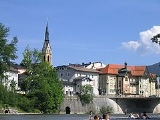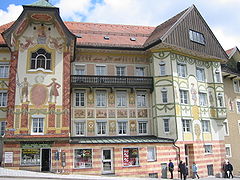
Bad Tölz
Encyclopedia

Bavaria
Bavaria, formally the Free State of Bavaria is a state of Germany, located in the southeast of Germany. With an area of , it is the largest state by area, forming almost 20% of the total land area of Germany...
, Germany
Germany
Germany , officially the Federal Republic of Germany , is a federal parliamentary republic in Europe. The country consists of 16 states while the capital and largest city is Berlin. Germany covers an area of 357,021 km2 and has a largely temperate seasonal climate...
, and administrative center of the district of Bad Tölz-Wolfratshausen
Bad Tölz-Wolfratshausen
Bad Tölz-Wolfratshausen is a district in Bavaria, Germany. It is bounded by Austria and the districts of Garmisch-Partenkirchen, Weilheim-Schongau, Starnberg, Munich and Miesbach.- History :...
.
History
Since the retreat of the glaciers at the end of the Ice Age, archaeology has shown continuous occupation of the site of Bad Tölz. For example, there are finds from the Hallstatt culture, as well as from Roman Raetia, or at least occupation by romanized Celts.The name "Tölz" (as "Tolnze") appears relatively late in documentation at the end of the 12th century. The name "Reginried" appears as that of a settlement belonging to the monastery at Tegernsee in earlier texts, which is probably the same as Reid in the western part of Mühlfeld.
Hainricus de Tolnze built a castle on the site, which controlled the river and road traffic in the region, but which no longer exists. In 1331 Louis IV
Louis IV, Holy Roman Emperor
Louis IV , called the Bavarian, of the house of Wittelsbach, was the King of Germany from 1314, the King of Italy from 1327 and the Holy Roman Emperor from 1328....
made Tölz a market town.
The 14th century saw Tölz become a crossroads for the salt and lumber traffic on the Isar
Isar
The Isar is a river in Tyrol, Austria and Bavaria, Germany. Its source is in the Karwendel range of the Alps in Tyrol; it enters Germany near Mittenwald, and flows through Bad Tölz, Munich, and Landshut before reaching the Danube near Deggendorf. At 295 km in length, it is the fourth largest river...
. In 1453 the market street, church, and castle were destroyed by fire. Duke Albrecht III
Albert III, Duke of Bavaria
Albert III the Pious of Bavaria-Munich , , since 1438 Duke of Bavaria-Munich. He was born to Ernest, Duke of Bavaria and Elisabetta Visconti, daughter of Bernabò Visconti.-Life:Albert was born in Munich....
enabled the city to rebuild, but this time in stone. He also built a palace which stood until 1770 when it fell into disrepair, and was eventually undermined by the Ellbach
Ellbach
Ellbach is a river of Saarland, Germany. It drains into the Rhine and is 8 kilometers long....
.
The Thirty Years' War
Thirty Years' War
The Thirty Years' War was fought primarily in what is now Germany, and at various points involved most countries in Europe. It was one of the most destructive conflicts in European history....
(1618 – 1648) brought plague
Pandemic
A pandemic is an epidemic of infectious disease that is spreading through human populations across a large region; for instance multiple continents, or even worldwide. A widespread endemic disease that is stable in terms of how many people are getting sick from it is not a pandemic...
and destruction to the region. During the War of the Spanish Succession
War of the Spanish Succession
The War of the Spanish Succession was fought among several European powers, including a divided Spain, over the possible unification of the Kingdoms of Spain and France under one Bourbon monarch. As France and Spain were among the most powerful states of Europe, such a unification would have...
things began to turn around again, with trade in lime and wood products, among other items. During this war, in 1705, the vintner Johann Jäger of Tölz led a band of farmers to battle at Sendling
Sendling
Sendling is a borough of Munich. It is located south-west of the city centre and spans of the city boroughs Sendling and Sendling-Westpark. Sendling is sub-divided into Obersendling, Mittersendling and Untersendling...
(south of Munich
Munich
Munich The city's motto is "" . Before 2006, it was "Weltstadt mit Herz" . Its native name, , is derived from the Old High German Munichen, meaning "by the monks' place". The city's name derives from the monks of the Benedictine order who founded the city; hence the monk depicted on the city's coat...
).
In the middle of the 19th century, Tölz changed directions with the discovery of natural springs. The town began to focus on the healing properties of these spring, and became a cure and spa town. In 1899 it became known as Bad Tölz. The town is also known as a pilgrimage site; on November 6 there is a festival to Saint Leonard of Noblac. In 1718 a chapel was built in his honor on the Calvary hill.
In 1937 SS-Junkerschule Bad Tölz
SS-Junkerschule Bad Tölz
SS-Junkerschule Bad Tölz was the officers' training school for the Waffen-SS. It was the SS equivalent of Britain's Sandhurst and the USA's West Point. The school was established in 1937, in the town of Bad Tölz which is about 30 miles south of Munich and the location was seemingly chosen because...
was established near the town. The SS-Junkerschule (SS Officer Candidate School) operated until the end of World War II
World War II
World War II, or the Second World War , was a global conflict lasting from 1939 to 1945, involving most of the world's nations—including all of the great powers—eventually forming two opposing military alliances: the Allies and the Axis...
in 1945. As well, a subcamp of the Dachau concentration camp was located in the town. It provided labour for the SS-Junkerschule and the Zentralbauleitung (Central Administration Building). The former SS-Junkerschule was the base of the U.S. Army's 1st Battalion, 10th Special Forces Group until 1991.
Bad Tölz is known for its spas
Spas
The article is about localities in Eastern Europe.Spas in the Slavic languages means saviour and past-tense of to save ....
, historic medieval town, and spectacular views of the alps
Alps
The Alps is one of the great mountain range systems of Europe, stretching from Austria and Slovenia in the east through Italy, Switzerland, Liechtenstein and Germany to France in the west....
. On the western bank of the Isar
Isar
The Isar is a river in Tyrol, Austria and Bavaria, Germany. Its source is in the Karwendel range of the Alps in Tyrol; it enters Germany near Mittenwald, and flows through Bad Tölz, Munich, and Landshut before reaching the Danube near Deggendorf. At 295 km in length, it is the fourth largest river...
River lies the Kurverwaltung, or modern spa
Thermal bath
A thermal bath is a warm body of water. It is often referred to as a spa, which is traditionally used to mean a place where the water is believed to have special health-giving properties, though note that many spas offer cold water or mineral water treatments.A thermal bath may be part of a...
, whose iodine
Iodine
Iodine is a chemical element with the symbol I and atomic number 53. The name is pronounced , , or . The name is from the , meaning violet or purple, due to the color of elemental iodine vapor....
-rich waters are known for their soothing and healing powers. A major attraction is the Alpamare, Europe's first indoor waterpark with long waterslides, wavepool, a surf wave and a range of thermal outdoor pool with iodine water. Another major attraction is Stadtpfarrkirche, a church built in 1466, which is an excellent example of German late-Gothic architecture
Gothic architecture
Gothic architecture is a style of architecture that flourished during the high and late medieval period. It evolved from Romanesque architecture and was succeeded by Renaissance architecture....
.
Geography
Bad Tölz sits on the IsarIsar
The Isar is a river in Tyrol, Austria and Bavaria, Germany. Its source is in the Karwendel range of the Alps in Tyrol; it enters Germany near Mittenwald, and flows through Bad Tölz, Munich, and Landshut before reaching the Danube near Deggendorf. At 295 km in length, it is the fourth largest river...
River, 670 metres above sea level. It occupies 30.8 square kilometres.
Transportation
Bad Tölz is served by the MunichMunich
Munich The city's motto is "" . Before 2006, it was "Weltstadt mit Herz" . Its native name, , is derived from the Old High German Munichen, meaning "by the monks' place". The city's name derives from the monks of the Benedictine order who founded the city; hence the monk depicted on the city's coat...
to Lenggries
Lenggries
Lenggries is a municipality in Bavaria, Germany. Lenggries is the center of the Isarwinkel, the region along the Isar between Bad Tölz and Wallgau...
line of the Bayerische Oberlandbahn railway (Green Line).
Culture
- Bad Tölz is the setting of the popular television series, Der Bulle von TölzDer Bulle von TölzDer Bulle von Tölz is an Austrian-German television series which has been produced and broadcast by SAT.1 and the ORF since 1996. As of January 2009, 69 self-contained feature-length episodes have been made.-Genre:...
. - Tölzer KnabenchorTölzer KnabenchorThe Tölzer Knabenchor is a boys' choir with roots in the Bavarian town of Bad Tölz.The choir group is still led by director and singing master Gerhard Schmidt-Gaden, who founded the choir in 1956 when he was only nineteen years old. The founder was once a student of Carl Orff's and worked with him...
- a world-famous boys choir. - Bad Tölz is famous for the hockey club EC Bad Tölz (also known as Tölzer Löwen)

